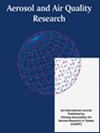稀土掺杂氧化铁催化剂合成条件对NH3选择性催化还原NOx的影响
IF 2.5
4区 环境科学与生态学
Q3 ENVIRONMENTAL SCIENCES
引用次数: 0
摘要
采用共沉淀法制备了一系列稀土掺杂铁基氧化物催化剂作为选择性催化还原(SCR)催化剂。系统考察了稀土种类、Sm掺杂量、煅烧温度和沉淀剂种类对催化剂deNO x活性的影响。在最佳催化剂上测试了其抗so2性能。采用x射线衍射(XRD)、x射线光电子能谱(XPS)、扫描电子显微镜(SEM)和Brunner Emmet Teller (BET)对催化剂进行了表征。结果表明,Sm的掺杂显著提高了铁基氧化物的去除率。Sm 0.075 Fe 0.925催化剂表现出最佳的deNO x性能和优异的抗so2性能。在最佳掺杂率(0.075)下,在200 ~ 250℃间脱氮率接近100%,煅烧温度对催化剂的影响显著。催化活性的顺序对不同煅烧温度为350°C≈400°C > 450°C > 500°C . Sm 0.075铁0.925实现100% de-NOx效率的煅烧温度350 - 400°C,也发现deNO x催化剂的性能由使用NH 3·H 2 O作为沉淀剂比催化剂由使用(NH 3) 2 . 3或氢氧化钠为沉淀剂。通常情况下,少量的so2会使催化剂失活,但在本次阻力试验中,Sm 0.075 Fe 0.925催化剂在去除0.05%的so2后基本再生。本文章由计算机程序翻译,如有差异,请以英文原文为准。
Effects of Synthesis Conditions on Rare Earth Doped Iron Oxide Catalyst for Selective Catalytic Reduction of NOx with NH3
A series of rare earth-doped Fe-based oxide catalysts were prepared by co-precipitation method as Selective Catalytic Reduction (SCR) catalysts. The effects of the various rare earth species, doping amount of Sm, calcination temperature and the kind of precipitant on the deNO x activity of the catalysts were systematically investigated. The SO 2 resistance performance was tested on the optimal catalyst. The catalysts have been characterized by X-ray diffraction (XRD), The X-ray photoelectron spectra (XPS), scanning electron microscopy (SEM) and Brunner Emmet Teller (BET). The results showed that the doping of Sm significantly improves the removal efficiency of Fe-based oxides. Sm 0.075 Fe 0.925 catalyst showed the optimal deNO x performance and excellent resistance to SO 2 . At the optimal doping rate (0.075), the denitrification rate was close to 100% between 200 and 250 ° C. The calcination temperature has a significant effect on the catalyst. The order of catalytic activity for different calcination temperatures was 350 ° C ≈ 400 ° C > 450 ° C > 500 ° C. The Sm 0.075 Fe 0.925 achieved 100% the de-NOx efficiencies at calcination temperatures of 350–400 ° C. It was also found that the deNO x performance of the catalyst prepared by using NH 3 ·H 2 O as the precipitating agent was better than the catalyst prepared by using (NH 3 ) 2 CO 3 or NaOH as the precipitating agent. Normally a small amount of SO 2 would render the catalyst inactive, but the Sm 0.075 Fe 0.925 catalyst was basically regenerated after 0.05% SO 2 removal in this resistance test.
求助全文
通过发布文献求助,成功后即可免费获取论文全文。
去求助
来源期刊

Aerosol and Air Quality Research
ENVIRONMENTAL SCIENCES-
CiteScore
8.30
自引率
10.00%
发文量
163
审稿时长
3 months
期刊介绍:
The international journal of Aerosol and Air Quality Research (AAQR) covers all aspects of aerosol science and technology, atmospheric science and air quality related issues. It encompasses a multi-disciplinary field, including:
- Aerosol, air quality, atmospheric chemistry and global change;
- Air toxics (hazardous air pollutants (HAPs), persistent organic pollutants (POPs)) - Sources, control, transport and fate, human exposure;
- Nanoparticle and nanotechnology;
- Sources, combustion, thermal decomposition, emission, properties, behavior, formation, transport, deposition, measurement and analysis;
- Effects on the environments;
- Air quality and human health;
- Bioaerosols;
- Indoor air quality;
- Energy and air pollution;
- Pollution control technologies;
- Invention and improvement of sampling instruments and technologies;
- Optical/radiative properties and remote sensing;
- Carbon dioxide emission, capture, storage and utilization; novel methods for the reduction of carbon dioxide emission;
- Other topics related to aerosol and air quality.
 求助内容:
求助内容: 应助结果提醒方式:
应助结果提醒方式:


